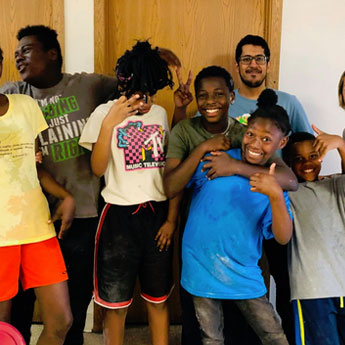
Where Pineapple Way Steps In
Where Pineapple Way Steps In

According to the CDC, US students receive less than 8 hours of required nutrition education each school year, far below the 40 to 50 hours that are needed to affect behavior change?. We here at Pineapple are firm believers in the power of not only providing food (which alone seems unsuccessful based on SNAP data), but also educating children on nutrition. We feel it is time to step up and give children of all backgrounds greater access to nutrition education to reap its many benefits, as demonstrated in studies done in the United States. It’s been found that nutrition education increases the self-efficacy of children as well as their likelihood of creating healthy habits at a young age?. By simply teaching children, they are able to take these skills with them beyond the classroom and apply them in their own lives. Thus, it’s no surprise that when it comes to obesity, nutritional education decreases the risk of obesity among elementary students by decreasing their BMIs and waist circumferences?. Nutritional education seems to also have a great impact on cognition, as well. A study found that nutritional education improves cognitive development and decreases behavioral outbursts in an educational setting (4). Importantly, these cognitive benefits are seen in academic performance. One study examined the academic performance of children in the 5th and 6th grades, and researchers discovered students who had healthier habits were significantly more likely to meet academic test score targets?. These improvements have far-reaching implications for a neighborhood’s future generations: with improved test scores, schools can obtain more funding from the state government, which can be used to supply and maintain classroom equipment needed to educate the next generation of students?. Great benefits are also seen when children are not only learning about nutrition, but also participating in hands-on cooking lessons. This is shown in a study done on underserved elementary and middle school students in Chicago, where students participated in an experiential cooking and nutrition education program after school for ten weeks. Even six months after this ten-week experimental period, children showed increased nutrition knowledge, increased cooking self-efficacy, and increased vegetable consumption. This study also showed an improvement in family dynamics: parents reported an increase in family conversations about healthy food and an increase in how often their children helped prepare dinner. On the flip side, these same parents also found that they began to place greater emphasis on sharing a family meal together at home?. Nutrition education and cooking classes thus have far-reaching impacts on many aspects of a child’s life, which is why Pineapple is pursuing the goal of not only reaching out to as many children in Chicago as possible, but also creating deliberate and meaningful experiences that these children can take with them for a lifetime.
“Nutrition Education in US Schools.” Centers for Disease Control and Prevention, Centers for Disease Control and Prevention, 15 Feb. 2021,https://www.cdc.gov/healthyschools/nutrition/school_nutrition_education.htm
xWall, Denise E., et al. “Nutrition Education Intervention Improves Vegetable‐Related Attitude, Self‐Efficacy, Preference, and Knowledge of Fourth‐Grade Students.” Wiley Online Library, John Wiley & Sons, Ltd, 6 Dec. 2011,https://onlinelibrary.wiley.com/doi/10.1111/j.1746-1561.2011.00665.x
xFairclough, Stuart J et al. “Promoting healthy weight in primary school children through physical activity and nutrition education: a pragmatic evaluation of the CHANGE! randomized intervention study.” BMC public health vol. 13 626. 2 Jul. 2013, doi:10.1186/1471-2458-13-626https://www.ncbi.nlm.nih.gov/pmc/articles/PMC3733685/
xIckovics, Jeannette R et al. “Health and academic achievement: cumulative effects of health assets on standardized test scores among urban youth in the United States.” The Journal of school health vol. 84,1 (2014): 40-8. doi:10.1111/josh.12117https://pubmed.ncbi.nlm.nih.gov/24320151/
xSchool Nutr Brief – School of Public Health – University …http://www.epi.umn.edu/let/wp-content/uploads/2018/05/school-nutr-brief.pdf
xJarpe-Ratner, Elizabeth, et al. “An Experiential Cooking and Nutrition Education Program Increases Cooking Self-Efficacy and Vegetable Consumption in Children in Grades 3-8.” Journal of nutrition education and behavior vol. 48,10 (2016): 697-705.e1. doi:10.1016/j.jneb.2016.07.021https://pubmed.ncbi.nlm.nih.gov/27575849/
x
The Demographics We Serve
Women and Children in Homeless Shelters of Chicago underserved and food insecure communities
Learn More
The Link Between Childhood Obesity and Poverty
Learn More
Is SNAP Helping the Homeless?
Learn MoreLet’s bring the taste of home to homeless children!
Sponsor a surprise box
Click Here
X
 Get New Password
Get New Password
Make a Donation
Help us fight obesity at its source and give our future generations the skills for a healthy lifetime.Your donation will help us to broaden the horizon of kids who have not been exposed to the joys and benefits of healthy eating.
Payment
Information
Information
Fill in all the fields for a secure donation
Title
Thank you!
Lost Password
Please enter your email address. You will receive an email message with instructions on how to reset your password. Get New Password
Get New Password

